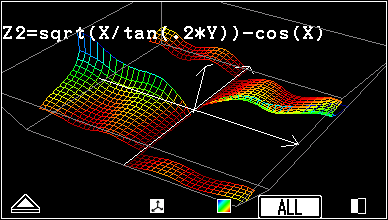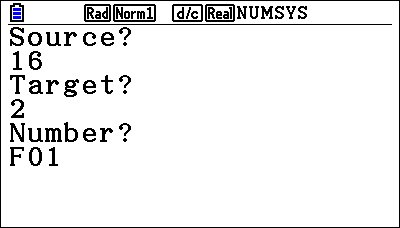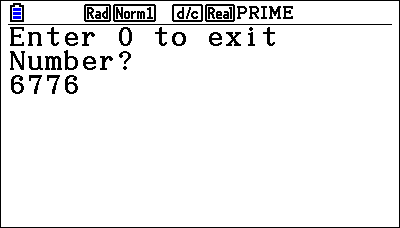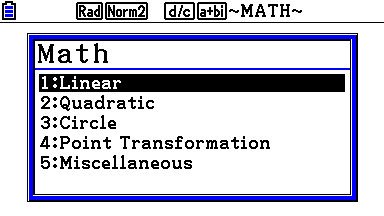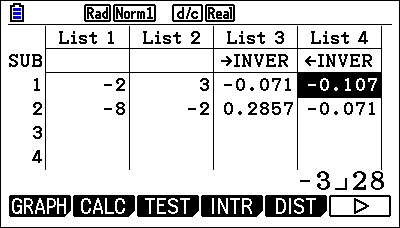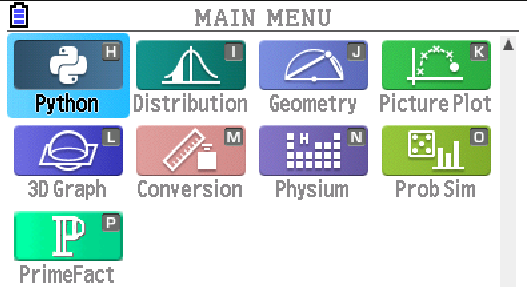Casio Prizm programs for all versions of the calculator. Some programs designed for earlier versions (the CG10 and CG20) may not work correctly on newer calculators (the CG50). We have a guide for how to put programs on the calculator. Lua programs also need LuaZM to run.
Categories
Files
-
This is a port of the powerful Eigenmath math engine, by George Weigt, to the Casio Prizm, providing numerous math functions not originally available in these calculators, including symbolic computation. This port includes a function catalog, ability to create and execute scripts, draw graphs, and much more. All 100+ Eigenmath commands work. Output is pretty-printed whenever possible, and 200 lines of output are stored for scrolling at any time. Command execution can be stopped. The state of the add-in is optionally automatically saved when exiting. Source code and more info is available at: https://github.com/gbl08ma/eigenmath .
Categorized under:
This add-in will surely become an indispensable part of your calculator. -
Graph3DP is a powerful 3D graphing application for the Casio Prizm (fx-CG10/fx-CG20/fx-CG50). Enter one to six 3D equations, and rotate and zoom the resulting graph. You can adjust the window and trace over the mesh to examine X, Y, and Z value. This final 1.0 release has been thoroughly tested, and the underlying equation-parsing system, AHelper's gCAS2, has been overhauled for speed and correctness. Graph3DP understands thirteen built-in math functions, from sin() to atan() to sqrt() to ln(), plus addition, subtract, multiplication, division, grouping, and exponentiation. Give it a download and try it today; this will surely become an permanent fixture on your Casio Prizm.
Categorized under: -
This is a simple number system converting tool for Casio calculators written in BASIC
Categorized under: -
This is a prime factorization tool for Casio calculators written in BASIC
Categorized under: -
Updated file of Discriminant
This program finds the discriminant of a 2nd degree trinomial,
does the quadratic formula,
and solves for k in direct, inverse, and joint variation,Soon to come:
Categorized under:
Right now I'm working on turning this into an Add-in. So the next version will (hopefully) be in Add-in form. -
~MATH~ is just a simple program I made for the Casio fx-CG50 by combining all of the many math programs I'd already made to speed up the homework process. I basically made a program for everything I could when we learned it, so some of the functions in here will seem really random. Also, I'm only in Algebra 2, so don't expect anything mind-blowing. Also, I put a password on the program so that breaking (AC/ON) to exit wouldn't bring you to the source code. If you would like to view the source code, the password is "MATH"
Categorized under: -
Updated file of discriminant
Categorized under: -
Complete matrix calculation for Graph 25+Pro and FX-7400GII:
Invert (INVERSE)
Raise to higher power (M HOCH X)
Multiplication with scalar (M MAL X)
Multiplication with matrix (M MAL M)
Determinant (REFDET)
Gaussian elimination (REFDET)
Gauss–Jordan elimination (RREF)Editing
Copy matrix to other lists (KOPIEREN)
Generate a random matrix (M ERZEUG)Input of matrices in then lists of the STAT-application, calculation in PRGM-application, result again in STAT-application.
Categorized under: -
Distributions calculation for Graph 25+Pro and FX-7400GII:
These are programs to calculate probability, cumulative probability, inverse cumulative probability of:
- Binomial distribution
Categorized under:
- Geometric distribution
- Hypergeometric distribution
- Normal distribution
- Poisson distribution -
Program written in Casio Basic that lets you enter positive integers larger than 69 and calculate: n! , n^r , nPr , nCr
Categorized under: -
Hello there!
Thank you for downloading my Algebra Pack!
In this program, you can:
-Find the volume of given geometrical features
Examples:
-- Sphere
-- Cone
-- Cube
-- Cylinder
-- Pyramid
-- Rectangular Prism
-Solve for Positive & Negative roots using the quadratic equation
-Find unknown sides of a right triangle using the Pythagorean theorem
-Find the slope using the slope-formula
-Find the Circumference & Area of a Circle
-Find the Area & Perimeter of a Square
-Find the Range & Mean(Avg.) of given numeric valuesVersion 1.02.7 (October 12th, 2020)
-Fixed Quadratic Equation Non-Real Errors
-Added 3 new Volumes to Volume Menu (Cube, Cone, Sphere)
-Patched Bugs within the Code1.02.6 (June 16th, 2020)
-Created Quadratic Equation Menu
Categorized under:
-Fixed Volume Bugs -
This file contains 13 programs for the CASIO fx CG50: AFRAC, a program that uses continued fraction, and can give you a good approximation, as well as the exact value for denominators well above a million. APRIME: A prime finder which divides out all even numbers as well as numbers divisible with three, from number five. CFRAC, a simple and fast routine for fractions. DIVISOR: Gives the divisors of an integer, using the Augment(-utility. It also shows you the sum of all the divors, except the biggest one. LCM: The algorithm that Euclid found. Also shows the GCD. PERIOD: Shows you the period of a fraction. POLYDIV: A simple and concise program for dividing polynomials. POLYMULT: As simple as possible a program for multiplying polynomials. PRIME1: An elementary prime factor program. Shows the result as a list. PRIME2: A prime factor finder that uses a list of numbers, a piece of Erathosthenes sieve, to divide out the primes. Very fast. PRIMES and PRIMES1, are two programs that gives you the prime numbers in an interval of your choice. SOLVERY: This is the main attraction in the collection. A polynomial solver that can find factors like 5x^6-3, and of course factors all the way down to 2x-1. It can also find second degree factors like: 2x^2-8x-7, 1x^2+8x-1. You input coefficients of the equations left part as a list. The right part has to be null. The result is also showed as lists. Remember that it is the size of the list that determines the degree: 5X^6 - 3, comes out as {5 0 0 0 0 0 -3}. UPDATE: The program has got an even better routine now for deciding the divisors of the first degree coefficients in the second degree factors. {72,189,-104,-198,165,-34} takes around 4 minutes, to solve to: {24,23,-17} and {3,5,-7,2}. Which is 20 seconds better than the previous version. This program gives you the rational factors, wether their roots are real or imaginary. Which is of the most interest.
Categorized under: -
Update: This is a somewhat improved version of the original SYNDIV, with 1840 bytes, down from 1916. I am including it in the file since you are still downloading it, trying to figure out which version is best. Well, here they are, both of them. As you will see, SYNDIV1 is the better one, faster and with fewer bytes, and with the ability to enter the terms in any order.
Making a port from TI-Basic to Casio-basic, was a bad idea. Trying to think in TI’s basic and then put it on a Casio does not make Casio justice, as you can see in the previous versions. So, I’ve made a new program from scratch, on my Casio fx CG50. The number of bytes have dropped from 1916 to 1196, and the program is much faster now. As in previous versions, you can only use x as variable, and only integer coefficients, but you can enter the terms in any order, and there can be more than one of the same degree. The lists however, are still presented one by one vertically, and the only limits for the number of polynomials you can enter, is memory and the degree of the first polynomial.
Categorized under: -
This is a tool that allows you to prime factorisation integers.
Categorized under: -
These two programs aim to find two prime numbers that have been multiplied with each other. PRIME6 is as simple as possible, and PRIME6D is a demo version. The idea is to find a number that is close to a multiple to one of the primes: plus, minus 167. To do that the program typically selects the first four and the last four digits to C and D. The demo version shows them and their GCD, and then prime factors them. Then they bring them to both to have a divisor 3 by subtracting 7 for C once unconditionally, and then repeatedly if necessary. This is done conditionally for D as well. The demo version then shows the initial product and the new values for C and D, plus what’s left in between them. the numbers are augmented to B, which is processed according to how many times 7 has been subtracted respectively. The demo version shows the value B divided with the two primes as it goes. I am grateful for input about how it works for you. I have not tried very many combinations yet, but it seems that when I input two Fermat primes, they are immune to the process, so there is a specific section in the program for them. Update: This version has had some bug fixes and cosmetic improvements.
Categorized under: -
This program solves polynomials using the Solve(-function. To avoid getting the same value it divides the function with the factors as it goes, Solve(y1,x, -100,100)->A, Solve(y1/(x-A),x, -100,100)->B. It can repeat this process up to four times, but it can also combine the roots to solve equations of a higher degree than four. The program can find second degree factors like: {2,-8,-7}, {1,8,-1} etc. It can also find factors like 5x^6 -3, all the way down to 2x-1.There is a subroutine, SOLVSUB, which has 1312 bytes, while the main program has 672 bytes, a total of 1984 bytes. If the program stops with a Can’t Solve, press EXIT to quit then, and if there is information missing, check list4 in MODE1. Sometimes the program factors the equation into both linear and quadratic factors. The advantage with this program compared with SOLVERY, is the speed: {72,189,-104,-198,165,-34} is factored to {24,23,-17} and {3,5,-7,2} in just a few seconds, while SOLVERY takes around four minutes and 20 seconds. The drawback is that SOLVERX can only find rational second degree factors which has real roots. You enter the left side coefficients of the equation as a list. The right side has to be null. A good idea is to have both programs on your calculator, and try with SOLVERX first.
Categorized under: -
Update of the text file. The programs are the same.This file contains five programs about roots. QUADRA gives the roots of the second degree equation, plus the Discriminant and the formulas involved. A3 gives the numerical solution to the third degree equation. RADICAL gives the reduced integer roots of a number. It is fairly simple, but no slouch. RADICAL1 has all the bells and whistles. For example, to reduce the square root of 1234567890, takes 26 seconds for RADICAL, while RADICAL1 does it in about a second. ROOT gives you the numerical value for positive roots of a number. It’s algorithm is very quick and exact.
Categorized under: -
Update: Fixed a bug in ADDMULT1. ADDMULT uses CFRAC, and ADDMULT1 uses Euclid’s algorithm to find the divisors. These programs are built on the fact that second degree equations with rational roots can be solved by dividing the coefficients in Ax^2+Bx+C=0, with A, and then select a pair of divisors in C/A that multiply to C/A and add up to B/A, then it follows that those divisors are the (rational) roots of the equation. The condition for that is of course that the root of the Discriminant is rational, as well as the coefficients. The programs are therefore showing the Discriminant and its root, as well as B/A and C/A for your convenience.
Categorized under: -
Update: This program is an experiment, but it is very fast compared to SOLVERY, for most polynomials, and also gives you the integer second degree factors, wether their roots are real or imaginary. Instead of going about to analytically test for second degree factors, it tries to conclude which factor is right by ”looking” at the resulting polynomial and the error list. This version has 608 bytes more than SOLVERY, and fixes several bugs in the previous version. I hope to get some response from you, wether you find it ok or not. Is it worth the extra bytes?
Categorized under:
File statistics are updated periodically, so numbers shown in this listing may not agree exactly with those shown on individual files.
Advertisement



